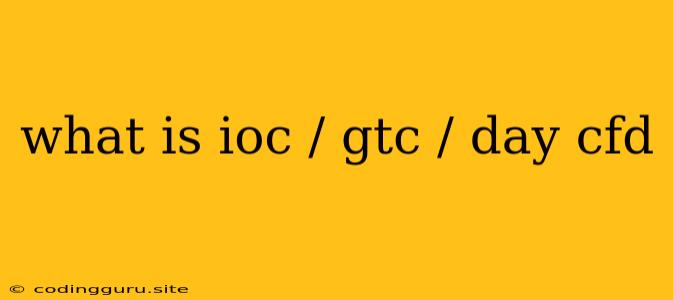Understanding Trading Orders: IOC, GTC, and Day Orders in CFD Trading
The world of CFD trading can seem complicated at first glance, with a multitude of order types and trading strategies available. But the most basic orders are those that tell your broker how long you want your order to be active. This is where IOC, GTC, and Day orders come into play. Each order type is a specific instruction to your broker about how you want your order to be executed. Let's explore the differences and nuances of these order types within the context of CFD trading.
What is an IOC (Immediate or Cancel) Order?
An IOC order, short for Immediate or Cancel, is a simple yet crucial order type. Imagine you want to buy a certain amount of CFDs at a specific price, but only if that price is available immediately. This is precisely what an IOC order does. It instructs your broker to execute your order instantly if the desired price is available. If not, the entire order is immediately canceled.
Example: You wish to buy 100 CFDs of Company XYZ at $50 per CFD. You place an IOC order. If the current price of XYZ is $50, the order is filled immediately. However, if the price is $51, the entire order is canceled.
Key Points:
- Speed: IOC orders are designed for immediate execution.
- No Partial Execution: You either get the full order filled or nothing at all.
- Market Volatility: IOC orders can be risky in volatile markets where prices fluctuate quickly, as there is no guarantee of execution.
What is a GTC (Good Till Cancelled) Order?
A GTC order, which stands for Good Till Cancelled, is the opposite of an IOC order. It's like a standing order that remains active until you explicitly cancel it. You set your desired price and quantity, and the broker will attempt to execute your order whenever the market price reaches your target. This makes GTC orders perfect for long-term or opportunistic trading strategies.
Example: You want to sell 50 CFDs of Company ABC at $100 per CFD. You place a GTC order. Even if the price doesn't reach $100 immediately, your order stays active until you cancel it or the price hits your target.
Key Points:
- Long-Term: GTC orders are ideal for longer-term trading strategies.
- Patience: They require patience as the order might not be filled immediately.
- Market Fluctuation: Be aware of market movements as prices may change significantly over time.
What is a Day Order in CFD Trading?
A Day order is a time-limited order that expires at the end of the trading day. This means the order will be active only until the market closes for the day. If the order isn't filled before the market closes, it is automatically canceled.
Example: You want to buy 200 CFDs of Company DEF at $25 per CFD. You place a Day order. If the price reaches $25 before the market closes, the order is filled. Otherwise, it expires at the end of the day.
Key Points:
- Time Limit: Day orders are restricted to the current trading day.
- Convenient: They are practical for shorter-term trading strategies.
- Risk Mitigation: Day orders reduce risk by limiting the order's lifespan to a single trading day.
Choosing the Right Order Type for CFD Trading
Selecting the appropriate order type is crucial for successful CFD trading. Each order type has its advantages and disadvantages. Consider these factors when choosing the best order type for your CFD trades:
- Trading Strategy: Do you have a short-term or long-term strategy?
- Market Conditions: Are market prices stable or volatile?
- Risk Tolerance: How much risk are you willing to take?
- Timeframe: Do you have immediate needs or can you wait for a favorable price?
Example Scenario:
You're a day trader and believe Company XYZ will rise in price shortly. You'd likely choose a Day order to capitalize on the potential price increase within the same trading day.
However, if you're a long-term investor and believe Company ABC will reach a specific price in the future, a GTC order would be the better option, allowing you to remain in the market until your price target is reached.
Conclusion
Understanding the nuances of IOC, GTC, and Day orders empowers you to make informed decisions in your CFD trading. Each order type serves a distinct purpose and caters to different trading styles and risk profiles. By carefully evaluating your trading strategy, market conditions, and risk tolerance, you can choose the most suitable order type for your specific CFD trades. Remember, choosing the right order type is a critical step towards maximizing your trading efficiency and success.
